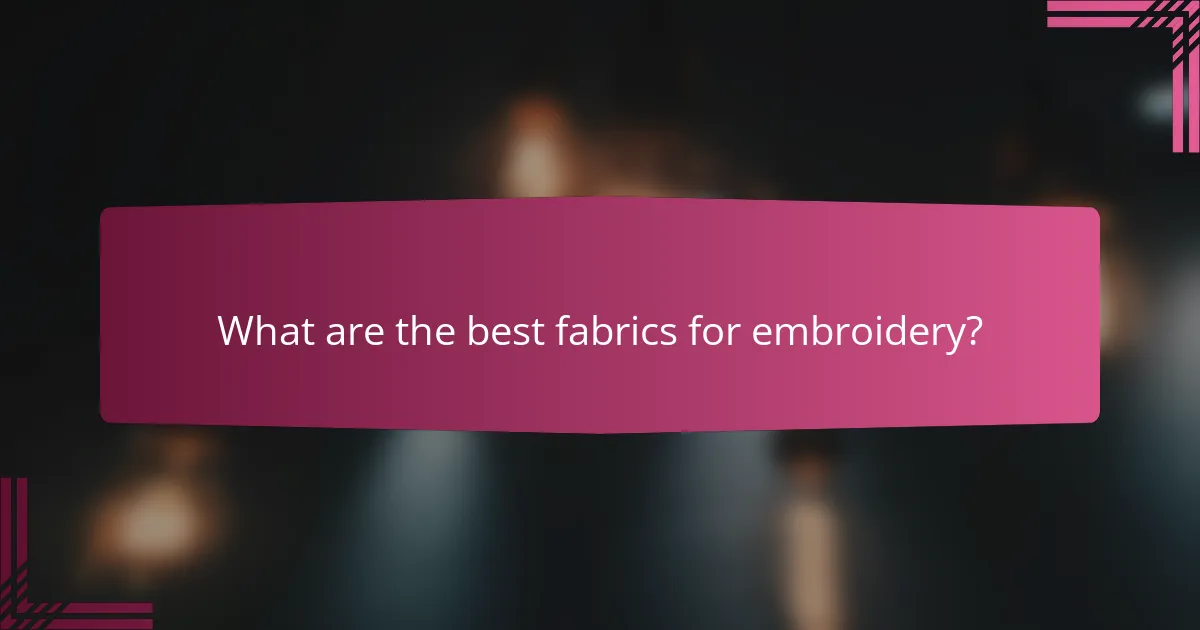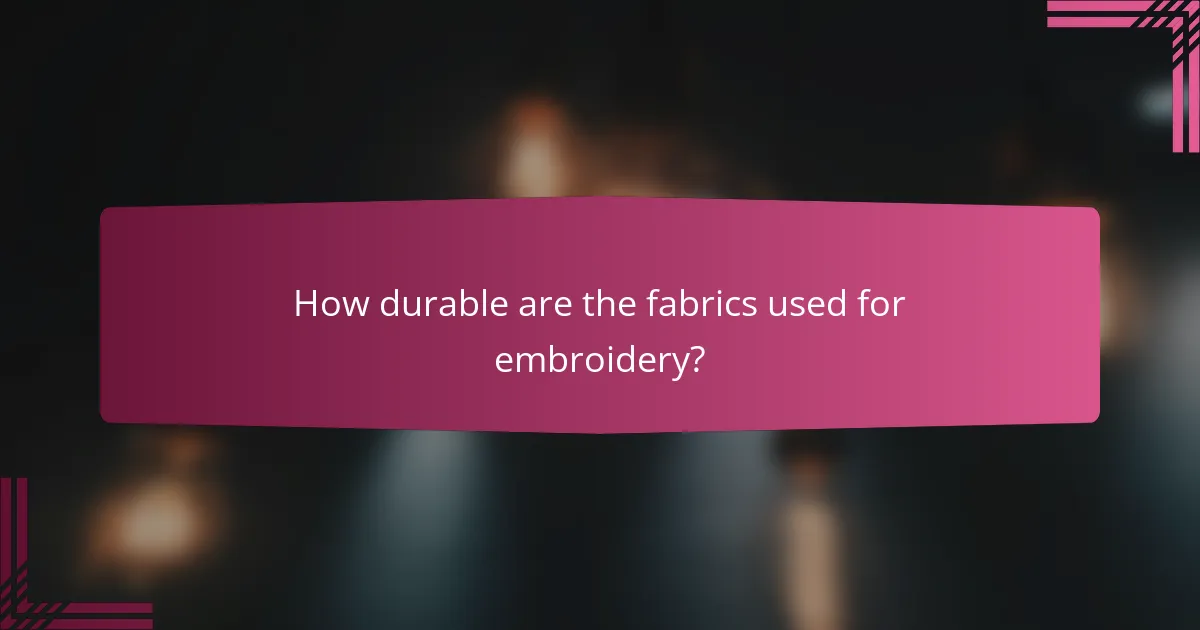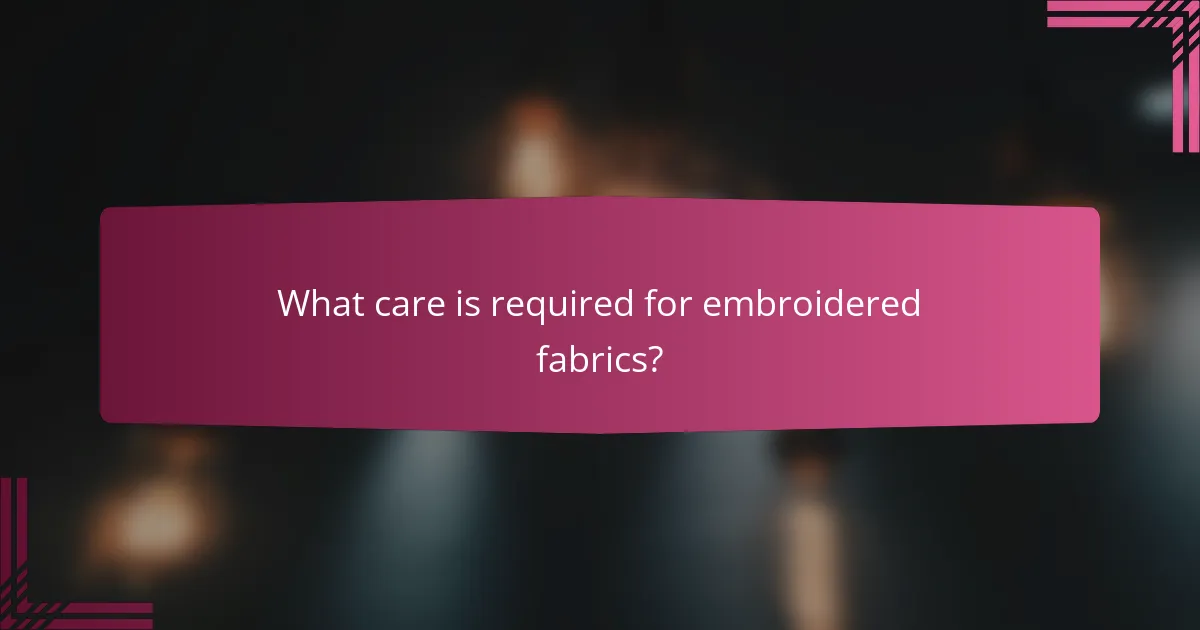
What are the best fabrics for embroidery?
The best fabrics for embroidery include cotton, linen, polyester, and silk. Cotton is widely used due to its softness and ease of handling. Linen offers a natural texture and durability, making it ideal for intricate designs. Polyester is favored for its strength and resistance to wrinkles. Silk provides a luxurious finish but requires careful handling. Each fabric type supports various embroidery techniques effectively. For instance, cotton is compatible with both hand and machine embroidery. Linen’s structure holds stitches well, preventing distortion. Polyester’s resilience ensures longevity in embroidered items. Silk is often chosen for high-end projects due to its sheen and drape.
How do different fabrics impact the quality of embroidery?
Different fabrics significantly impact the quality of embroidery. The choice of fabric affects the stitching, appearance, and durability of the final product. For instance, tightly woven fabrics like cotton or linen provide a stable base for embroidery. This stability minimizes distortion during the stitching process. In contrast, stretchy fabrics like knits can lead to uneven stitches. This can compromise the overall design quality. Additionally, the texture of the fabric influences how well the embroidery thread lays. Smooth fabrics allow for cleaner, sharper designs. Conversely, textured surfaces may obscure fine details. The weight of the fabric also plays a role; heavier fabrics can support more intricate designs. However, they may require special techniques to ensure proper tension. Overall, selecting the right fabric is crucial for achieving high-quality embroidery results.
What characteristics should be considered when choosing embroidery fabrics?
When choosing embroidery fabrics, consider the fabric’s weight, texture, and stability. Weight affects the drape and handling of the fabric. Lighter fabrics may require stabilizers for embroidery. Texture influences the visibility of the design. Smooth fabrics allow for clearer stitching. Stability is crucial for maintaining the shape during embroidery. Fabrics that stretch may distort designs. Fiber content also matters; natural fibers like cotton absorb dye well. Synthetic fibers offer durability and resistance to fraying. Lastly, consider the fabric’s care requirements. Some fabrics demand special washing or drying methods.
How does fabric weight affect embroidery results?
Fabric weight significantly influences embroidery results. Heavier fabrics typically provide more stability during the embroidery process. This stability leads to cleaner stitching and less distortion of the design. In contrast, lighter fabrics may shift or pucker, resulting in uneven embroidery. Furthermore, the thread tension can be affected by the fabric’s weight. A heavier weight allows for tighter tension without damaging the fabric. Conversely, lighter fabrics may require adjustments to avoid thread breakage. Studies show that optimal fabric weight enhances the overall quality of the embroidery. For instance, a weight of 5-7 oz per square yard is often recommended for best results.
What are the most common types of fabrics used for embroidery?
The most common types of fabrics used for embroidery include cotton, linen, polyester, and silk. Cotton is widely favored for its softness and versatility. Linen offers a textured surface that enhances the embroidery’s appearance. Polyester is durable and resistant to wrinkles, making it suitable for various projects. Silk provides a luxurious finish and a smooth texture for intricate designs. These fabrics are popular due to their unique properties that complement embroidery techniques.
What are the benefits of using cotton for embroidery?
Cotton offers several benefits for embroidery. It is highly absorbent, allowing for vibrant dye uptake. This results in rich and vivid colors in embroidery designs. Cotton is also soft and breathable, making it comfortable against the skin. Its natural fibers provide a smooth surface for stitching, reducing the risk of fraying. Additionally, cotton is durable and withstands frequent washing without losing its quality. It holds stitches well, ensuring that designs remain intact over time. Cotton’s versatility allows it to be used for various embroidery techniques, from hand stitching to machine embroidery.
How does polyester compare to other fabrics for embroidery?
Polyester is often preferred for embroidery due to its durability and versatility. It resists shrinking, stretching, and wrinkles, which helps maintain the integrity of embroidered designs. Polyester also has a smooth surface that allows for clean stitching and vibrant colors. Compared to natural fabrics like cotton, polyester withstands fading better when exposed to sunlight. Additionally, polyester is less prone to pilling, making it ideal for items that undergo frequent washing. Research shows that polyester blends can enhance the overall quality of embroidery work. This fabric’s ability to hold intricate designs makes it a popular choice among embroiderers.
What role does fabric texture play in embroidery?
Fabric texture significantly influences the quality and appearance of embroidery. Textured fabrics can enhance the visual depth of embroidered designs. For example, fabrics like velvet or corduroy provide a rich surface for stitches to stand out. Conversely, smooth fabrics such as cotton or satin offer a clean, flat base for detailed work. The choice of texture can also affect thread tension and stitch definition. A rough texture may lead to uneven stitching, while a fine texture allows for precision. Additionally, the texture can impact the durability of the embroidery. Textiles with a tighter weave generally hold stitches better than loosely woven materials. Therefore, fabric texture is crucial in achieving desired aesthetic and functional outcomes in embroidery.
How does a smooth fabric surface influence stitching?
A smooth fabric surface enhances stitching quality by allowing for consistent needle [censured]. Smooth surfaces reduce friction, which minimizes skipped stitches. This uniformity leads to cleaner and more precise embroidery designs. Fabrics like satin and silk are examples of smooth materials that facilitate effective stitching. Additionally, smooth fabrics help maintain thread tension, preventing thread breakage during the embroidery process. Studies in textile engineering confirm that smooth surfaces contribute to improved stitch formation and overall embroidery durability.
What are the effects of textured fabrics on embroidery designs?
Textured fabrics significantly influence embroidery designs. They create depth and dimension in the finished piece. The surface irregularities of textured fabrics can enhance the visual appeal of embroidery. Different textures can affect how thread lays and interacts with the fabric. For example, napped fabrics can obscure fine details, while smooth textures allow for crisp lines. Additionally, textured fabrics may require specific embroidery techniques to achieve the desired results. The choice of thread and stitch density can also be impacted by the fabric’s texture. Overall, understanding the effects of textured fabrics is crucial for successful embroidery design.

How durable are the fabrics used for embroidery?
The durability of fabrics used for embroidery varies by material. Common embroidery fabrics include cotton, polyester, and linen. Cotton is generally durable, with a high thread count providing strength. Polyester is known for its excellent durability and resistance to wear and tear. Linen, while strong, can be less durable than cotton and polyester when subjected to heavy use.
According to a study by the American Society for Testing and Materials, polyester fabrics can withstand more abrasion than cotton. This makes polyester a preferred choice for items needing high durability. Additionally, the care methods applied to these fabrics can impact their longevity. Proper washing and storage can enhance the durability of all embroidery fabrics.
What factors contribute to the durability of embroidery fabrics?
The durability of embroidery fabrics is influenced by several key factors. Fabric composition plays a crucial role; natural fibers like cotton offer breathability, while synthetic fibers like polyester provide strength. Stitch density affects durability; tighter stitches can withstand wear better. Thread quality is also significant; high-quality threads resist fraying and fading. The weight of the fabric impacts durability; heavier fabrics typically endure more stress. Additionally, the care and maintenance of the fabric contribute to its longevity; following washing instructions can prevent damage. Lastly, environmental factors such as UV exposure can degrade fabrics over time.
How does fabric composition affect its longevity in embroidery?
Fabric composition significantly affects its longevity in embroidery. Different fibers have varying durability and resistance to wear. Natural fibers like cotton may fray faster than synthetic fibers like polyester. Polyester is generally more resistant to fading and shrinking. Blends of fibers can offer a balance of comfort and durability. The thread count and weave also influence how well the fabric holds embroidery designs. Higher thread counts typically provide a sturdier base for intricate stitching. Research shows that synthetic fabrics often last longer in embroidered applications due to their resilience. Choosing the right fabric composition is crucial for maintaining the quality of embroidered items over time.
What testing methods are used to assess fabric durability?
Fabric durability is assessed using various testing methods. Common methods include the Martindale abrasion test, which measures fabric wear resistance through repeated rubbing. The Wyzenbeek test also evaluates abrasion resistance but uses a different mechanism involving a sliding motion. Tensile strength tests determine how much force a fabric can withstand before breaking. Tear strength tests assess the resistance to tearing when force is applied. Additionally, the pilling test measures the formation of small balls of fiber on the surface of the fabric. These methods provide quantifiable data on fabric durability, ensuring quality for applications like embroidery.
Which fabrics are known for their durability in embroidery projects?
Cotton and polyester are known for their durability in embroidery projects. Cotton is strong and resistant to wear, making it ideal for various applications. Polyester offers excellent strength and is less likely to shrink or wrinkle. Denim is another durable option, providing a sturdy base for embroidery. Canvas is also highly durable, often used for bags and outdoor items. These fabrics withstand repeated washing and maintain their integrity over time. Their durability ensures that embroidered designs remain intact and vibrant.
What makes denim a strong choice for embroidered items?
Denim is a strong choice for embroidered items due to its durability and texture. The fabric is made from cotton, which provides a sturdy base for intricate designs. Denim’s tight weave allows for clean, precise embroidery without fraying. Its weight also supports complex stitching without distortion. Additionally, denim holds colors well, ensuring vibrant embroidery that lasts. The fabric’s natural resilience makes it suitable for everyday wear and frequent washing. Denim’s ability to develop character over time enhances the visual appeal of embroidered items. This combination of durability and aesthetic quality makes denim a preferred option for embroidery.
How does canvas perform in terms of durability for embroidery?
Canvas is highly durable for embroidery. It withstands wear and tear effectively due to its robust fabric structure. The tight weave provides a stable base for embroidery designs. Canvas is less prone to fraying compared to lighter fabrics. It maintains its shape and integrity over time, ensuring long-lasting projects. Additionally, canvas can endure repeated washing without significant damage. This durability makes it suitable for both decorative and functional embroidery applications.
What maintenance practices enhance the durability of embroidered fabrics?
Regular washing and proper drying enhance the durability of embroidered fabrics. Use cold water and a gentle cycle to prevent wear. Avoid bleach, as it can damage the threads. When drying, air dry or use a low heat setting to minimize heat exposure. Iron the fabric inside out on a low setting to protect the embroidery. Store embroidered items in a cool, dry place to prevent mold and fading. These practices help maintain the integrity of the embroidery and prolong the life of the fabric.
How does proper washing affect the lifespan of embroidered fabrics?
Proper washing significantly extends the lifespan of embroidered fabrics. Gentle washing methods minimize wear and tear on the embroidery threads. Using cold water helps preserve the colors and prevents fading. Mild detergents are less harsh on the fabric and embroidery, reducing the risk of damage. Avoiding bleach protects the integrity of both the fabric and the embroidery. Air drying instead of machine drying prevents shrinkage and maintains the shape of the embroidered design. Following these washing guidelines can enhance the durability of embroidered items, ensuring they remain vibrant and intact for years.
What storage tips can help preserve embroidered items?
Store embroidered items in a cool, dry place to prevent moisture damage. Use acid-free tissue paper to wrap each piece gently. This helps avoid creases and maintains the embroidery’s shape. Avoid hanging embroidered items, as this can stretch the fabric. Instead, lay them flat in a storage box. Ensure the box is breathable to prevent mold growth. Protect items from direct sunlight to prevent fading. Regularly check stored items for signs of damage or pests. These practices help maintain the quality and appearance of embroidered pieces.

What care is required for embroidered fabrics?
Embroidered fabrics require gentle care to maintain their appearance and integrity. Hand washing is preferred to avoid damage from agitation. Use cold water and mild detergent for cleaning. Avoid bleach, as it can discolor the embroidery. Air drying is recommended to prevent shrinkage and distortion. If ironing is necessary, use a low heat setting and place a cloth between the iron and the fabric. Storing embroidered items flat or rolled helps prevent creasing. Following these care instructions extends the life of embroidered fabrics.
How should different fabrics be washed after embroidery?
Different fabrics should be washed after embroidery according to their specific care instructions. Cotton fabrics can be machine washed in cold water with mild detergent. Polyester blends should also be washed in cold water but can tolerate a gentle cycle. Silk requires hand washing in cold water to avoid damage. Linen should be washed in cold water on a gentle cycle to maintain its texture. Always air dry embroidered fabrics to prevent shrinkage and preserve the embroidery. Following these guidelines helps maintain the integrity of the fabric and the embroidery.
What are the best practices for hand washing embroidered items?
To hand wash embroidered items, start by filling a basin with cool water. Add a mild detergent specifically designed for delicate fabrics. Submerge the embroidered item gently and avoid scrubbing. Instead, lightly agitate the water to clean the fabric. Rinse the item thoroughly in cool water until all detergent is removed. Avoid wringing or twisting the fabric to prevent damage. Lay the item flat on a clean towel to absorb excess water. Finally, reshape the embroidered item and air dry away from direct sunlight. These practices help maintain the integrity of the embroidery and fabric.
How can machine washing affect the embroidery quality?
Machine washing can negatively affect embroidery quality. The agitation and heat during washing can cause stitches to fray or unravel. Additionally, harsh detergents may fade colors or weaken threads. Over time, repeated machine washing can lead to a loss of detail in the design. Proper care instructions should be followed to maintain embroidery integrity. Washing in cold water and using a gentle cycle can help preserve quality. Avoiding fabric softeners is also recommended, as they may coat threads and diminish their appearance.
What drying techniques are recommended for embroidered fabrics?
Air drying is the recommended technique for embroidered fabrics. This method prevents distortion of the embroidery and fabric. Lay the embroidered fabric flat on a clean, dry towel. Avoid wringing or twisting the fabric, as this can damage the stitches. If using a drying rack, ensure it is in a well-ventilated area. Keep the fabric out of direct sunlight to prevent fading. For quicker drying, a fan can be used to improve air circulation. Machine drying is generally not advised due to the risk of heat damage. Following these techniques helps maintain the quality of the embroidery.
Why is air drying preferred over machine drying for embroidered items?
Air drying is preferred over machine drying for embroidered items because it protects the delicate stitches. Machine drying can cause friction and heat, which may distort or damage the embroidery. Air drying allows for a gentle drying process that maintains the integrity of the fabric and design. Additionally, air drying reduces the risk of shrinking or warping the embroidered fabric. This method is also more environmentally friendly, as it consumes no electricity. Overall, air drying extends the lifespan of embroidered items by minimizing potential damage.
How can heat affect the embroidery on different fabrics?
Heat can significantly affect embroidery on different fabrics. High temperatures can cause fabric shrinkage, distorting the embroidery design. Synthetic fabrics like polyester may melt or warp under excessive heat. Natural fibers such as cotton may also suffer from fading or weakening when exposed to high heat. Additionally, heat can cause the adhesive used in embroidery to break down, leading to peeling or lifting of the thread. Proper heat settings during washing and ironing are crucial to maintain the integrity of the embroidery. Using a lower temperature can help preserve both the fabric and the embroidery details.
What are common troubleshooting tips for caring for embroidered fabrics?
To care for embroidered fabrics, ensure you follow specific troubleshooting tips. First, always wash embroidered items in cold water to prevent fading. Use a gentle detergent to avoid damaging the threads. When drying, air dry or use a low heat setting to maintain the fabric’s integrity. Avoid bleach as it can discolor the embroidery. If the embroidery becomes wrinkled, iron it on the reverse side using a low heat setting. For stains, treat them promptly with mild soap and water. Regularly check for loose threads and secure them to prevent further unraveling. Following these tips helps preserve the quality and appearance of embroidered fabrics.
How can you remove stains from embroidered fabrics without damage?
To remove stains from embroidered fabrics without damage, gently blot the stain with a clean, dry cloth. Avoid rubbing, as it can fray the embroidery. Use a mild detergent mixed with water for tougher stains. Apply the solution with a soft cloth or sponge, dabbing lightly. Rinse the area with cool water to remove detergent residue. Air dry the fabric away from direct sunlight to prevent fading. Always test any cleaning method on a hidden area first to ensure safety for the embroidery.
What should you do if the embroidery starts to fray or unravel?
To address fraying or unraveling embroidery, first, stop using the item to prevent further damage. Next, carefully trim any loose threads with sharp scissors. Avoid cutting the fabric itself; focus only on the frayed threads. Then, secure the area with a fabric glue or a small stitch to prevent additional unraveling. If necessary, consider re-embroidering the affected area for a clean finish. Regular maintenance can prevent future fraying, such as washing items gently and avoiding harsh detergents.
The main entity of this article is embroidery fabrics, specifically focusing on the best types for embroidery, their characteristics, durability, and care. Key fabrics discussed include cotton, linen, polyester, and silk, each with unique attributes that impact the quality of embroidery. The article explores how fabric weight, texture, and composition influence stitching results and longevity. Additionally, it provides maintenance practices to enhance the durability of embroidered items, including washing, drying, and storage techniques. Overall, this comprehensive overview aids in selecting the appropriate fabric for high-quality embroidery projects.
